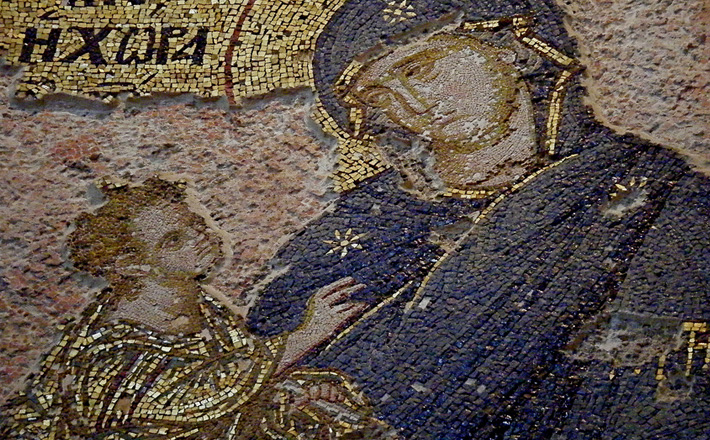Commentary on Luke 2:1-14 [15-20]
Ask any parent or grandparent about the birth of a new baby and they typically can describe the event in great detail.
I have been regaled with these stories too many times to count. Some birth stories get a lot more press than others, including the birth of Prince George in the UK. It seems people wanted to know every detail. But for many births we know very little.
As the mother of an adopted child from Russia, all I have is the police report that was made when my son was abandoned at the hospital in Yekaterinburg hours after his birth. The story told by his birthmother is in the report and gives me a glimpse into the story of his birth. It makes me a little sad, but also makes me feel extremely blessed every time I think of it.
Birth stories are often extremely powerful. They can immediately bring us back to a joyous moment, they can sadly remind us of some couple’s struggles with infertility, they can stir our imaginations of children hoped for, and they can make us aware of the difficult origin circumstances some folks had to overcome in their lives.
As most birth stories begin, the storyteller sets the stage. They describe the setting and the situation into which the child was born. They bring us into the realities of the event. In Luke we are told of the reason the family travelled so late in Mary’s pregnancy. We are brought into the place of the birth and why the location of his birth came about (verses 1-7). In Luke, this birth story follows the story of John’s birth, told in a similar fashion (1:57-80). These are joyous events, but also miraculous in so many ways.
The birth story of Jesus comes in three parts: the birth (verses 1-7), the proclamation of the birth to the shepherds (verses 8-20), and the circumcision and naming (verse 21). This is similar to the threefold structure of John’s birth story. In many ancient and modern stories we might very well see the same structure: the birth; the announcement of the birth to others; and the circumcision and naming of boys, the naming of girls and uncircumcised males, dedication or infant baptism. But we, as Christians, despite the similarities of stories, believe that the birth of Jesus was different from all births before or since. This is the birth story of all birth stories, because this is the birth story of the Messiah, the Son of God.
The historical accuracy of the story is debated due to questions regarding the census dates as described by Luke, but nonetheless, Mary and Joseph are in Bethlehem for the birth according to Matthew, Mark and Luke.1 The power of the story comes in its humbleness — a babe born in a stable or cave, wrapped in simple clothes, and laid to rest in an animal trough (verse 7).
The birth story is one of simplicity; the first ones told of the birth of the Messiah are shepherds out in the fields (verses 8-12). This is who Luke tells us learned of the event before all others. This is a stunning fact. It parallels a connection to the marginalized, the lowly, and the common and often unacceptable people of first century Judea that will be present throughout Jesus’ life and ministry. It reminds us that these are the very people who Jesus will invite to be part of the Kingdom of God. These are the very people Jesus wants at a banquet of the Kingdom of God (14:13, 21).2 What a glimpse into his future life this birth story provides. And what a life he will lead.
But for now he is a tiny baby with a birth story that is uniquely powerful in its simplicity. He is the son of God, but he is also the child of a young mother spent from labor and the son of a carpenter possibly unsure of how he will parent this newborn child.
Many new parents have fears and dreams for their newborns. Many worry about how their children’s lives will turn out and if they will be happy. Some are confronted with a child’s illness from the outset, while others will deal with significant health concerns for their children later on in life. Some will be close to their children and some will never learn to relate. Many will face tough teenage and young adult years. Many will watch their children thrive and succeed. Some have had many complications in completing adoptions processes. Many will just try to survive the pain of a child they will never get to raise themselves.
My mother told me, shortly after adopting my son, that all I can do is my best and then leave the rest to God and the lessons I taught him in the years he is in my care. I imagine that is part of what Mary is feeling. She is exhausted but happy. She is concerned but hopeful. And she knows that God has a role in her son’s life unlike anything the world had seen or heard of before.
This is, after all, Christmas Eve and we should all be happy now, right? But that is not true for all who will hear you preach this night. In preaching this text, the sermon should be sensitive to the various realities of birth stories, childbirth and infertility, and child-rearing. Extoling the joys of parenting in the message may bring significant pain to some of your listeners. The preacher should also be aware that for many the holidays are not a very joyous time. Being delicate in regard to the realities of your context will be key.
Preaching a text about the birth of the hope of the world — a baby wrapped in simple cloths and laid in a manger — can offer an entry point into these varied situations. It is, after all, the birth story of all birth stories.
1 Fred B. Craddock, Luke (Louisville: John Knox Press, 1990), 34-35.
2 Craddock, Luke, 36.


December 24, 2013